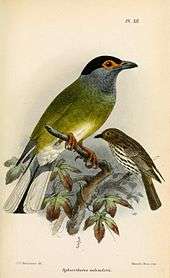Australasian figbird
| Australasian figbird | |
|---|---|
 | |
| A pair in Queensland, Australia | |
| Scientific classification | |
| Kingdom: | Animalia |
| Phylum: | Chordata |
| Class: | Aves |
| Order: | Passeriformes |
| Family: | Oriolidae |
| Genus: | Sphecotheres |
| Species: | S. vieilloti |
| Binomial name | |
| Sphecotheres vieilloti Vigors & Horsfield, 1827 | |

The Australasian figbird (Sphecotheres vieilloti) is a conspicuous medium-sized passerine bird native to a wide range of wooded habitats in northern and eastern Australia, southern Papua New Guinea, and the Kai Islands in Indonesia.[2] It was formerly considered a subspecies of S. viridis, then simply referred to as the figbird (a name still commonly used in Australia, where the Australasian figbird is the only figbird). It is common in large parts of its range, and occurs in numerous protected areas. Consequently, it is rated as Least Concern by BirdLife International and the IUCN.[1]
Taxonomy
Traditionally, all figbirds have been considered part of a single species, S. viridis, but all recent major authorities recognize three species, the Australasian figbird (S. viieilloti), the Timor figbird (S. viridis) and the Wetar figbird.[2][3][4][5][6] The split is primarily based on differences in measurements and plumage, and on biogeography. Additionally, the Australasian figbird has sometimes been split into two separate species, the more northern, yellow figbird (S. flaviventris) and the green or southern figbird (S. vieilloti), but the two intergrade widely where they come into contact, supporting the view that they are part of a single biological species.[2]
The Australasian figbird has five subspecies, in taxonomic order:[2][3]
- S. v. cucullatus – Kai Islands in Indonesia. Possibly a junior synonym of S. v. flaviventris.[7]
- S. v. salvadorii – southern Papua New Guinea.
- S. v. ashbyi – northern Western Australia and Northern Territory, Australia.
- S. v. flaviventris – north-eastern Australia.
- S. v. vieilloti (nominate) – south-eastern and east-central Australia.
Description
The Australasian figbird has a total length of 27–29.5 cm (10.6–11.6 in)[8] and a jizz comparable to that of other orioles. It is sexually dimorphic, and the racial differences are almost entirely limited to the male. Males of all subspecies have a black tail with broad white tips to the outer rectrices, white crissum (the undertail coverts surrounding the cloaca), blackish primaries, a black head, distinct bright red facial skin, a black bill with a red base, and pinkish legs.[8] In the nominate subspecies, the body is largely olive-green, and the throat, neck and chest are grey. The subspecies cucullatus, ashbyi and flaviventris are yellowish olive-green above, and bright yellow below (including the throat).[2] The last subspecies, salvadorii, resembles previous, but with a grey throat, collar and chest similar to the nominate subspecies,[9] thereby giving it an intermediate appearance not unlike some hybrids between nominate and flaviventris in Australia.
Females are drab-coloured, being dull brownish above, and white below with strong dark streaking.[8] They have greyish facial skin, and a greyish-black bill. Juveniles resemble females, but the streaking below is typically not as strong. The other orioles in its range, the brown and olive-backed orioles, are superficially similar, but have entirely red bills when adult.[3][8]
Australasian figbirds make a large number of different short calls, and are also able to mimic the voice of other birds, for example parrots and other species of orioles.[2] The song consists of a series of simple whistles.[2]
Behaviour
As suggested by their name, Australasian figbirds are largely frugivorous,[8] but also take small insects, nectar and small seeds.[2] While largely a resident species (although the southern population may be migratory), it is nomadic in response to the availability of food.[2]
Unlike most orioles, Australasian figbirds are gregarious,[8] often forming flocks of 20 to 40 birds during the non-breeding season, and even breeding in small, loose colonies.[2] The flimsy saucer-shaped nest is made from plant-material, and usually placed relatively high in a tree. The clutch of two to four eggs is incubated by both sexes, and typically hatches after 16–17 days.[2] It has been recorded nesting near the aggressive spangled drongo and helmeted friarbird, possibly gaining an advantage as they keep potential nest-predators away. Australasian figbirds sometimes fall victim to nest parasitism by Pacific koels.[2]

References
- 1 2 BirdLife International (2012). "Sphecotheres vieilloti". IUCN Red List of Threatened Species. Version 2013.2. International Union for Conservation of Nature. Retrieved 26 November 2013.
- 1 2 3 4 5 6 7 8 9 10 11 12 Higgins, P. J., L. Christidis, & H. A. Ford (2008). Family Oriolidae (Orioles). pp. 692-731 in: del Hoyo, J., A. Elliott, & D. A. Christie. eds. (2008). Handbook of the Birds of the World. Vol. 13. Pendulin-tits to Shrikes. Lynx Edicions. ISBN 978-84-96553-45-3
- 1 2 3 Dickinson, E. C. (editor) (2003). The Howard and Moore Complete Checklist of the Birds of the World. 3rd edition, w. updates. Christopher Helm. ISBN 0-7136-6536-X
- ↑ Andrew, P. (1992). The Birds of Indonesia: A Check-list. Kukila Check-list No. 1. Indonesian Ornithological Society, Jakarta.
- ↑ Gill, F., M. Wright, & D. Donsker (2009). IOC World Bird Names. Version 2.1. Accessed 04-07-2009
- ↑ Christidis, L., & W. E. Boles (2008). Systematics and Taxonomy of Australian Birds. CSIRO. ISBN 978-0-643-06511-6
- ↑ Clements, J. F. (2007). The Clements Checklist of the Birds of the World. 6th edition, w. updates. Christopher Helm. ISBN 978-0-7136-8695-1
- 1 2 3 4 5 6 Simpson, K. (editor) & N. Day (illustrator) (1994). Field Guide to the Birds of Australia. 2nd edition. Christopher Helm. ISBN 0-7136-3930-X
- ↑ Coates, B. J., & W. S. Peckover. (2001). Birds of New Guinea and the Bismarck Archipelago. Dove Publications. ISBN 0-9590257-4-X
External links
- Figbird videos on the Internet Bird Collection
| Wikimedia Commons has media related to Sphecotheres vieilloti. |
| Wikispecies has information related to: Sphecotheres vieilloti |
